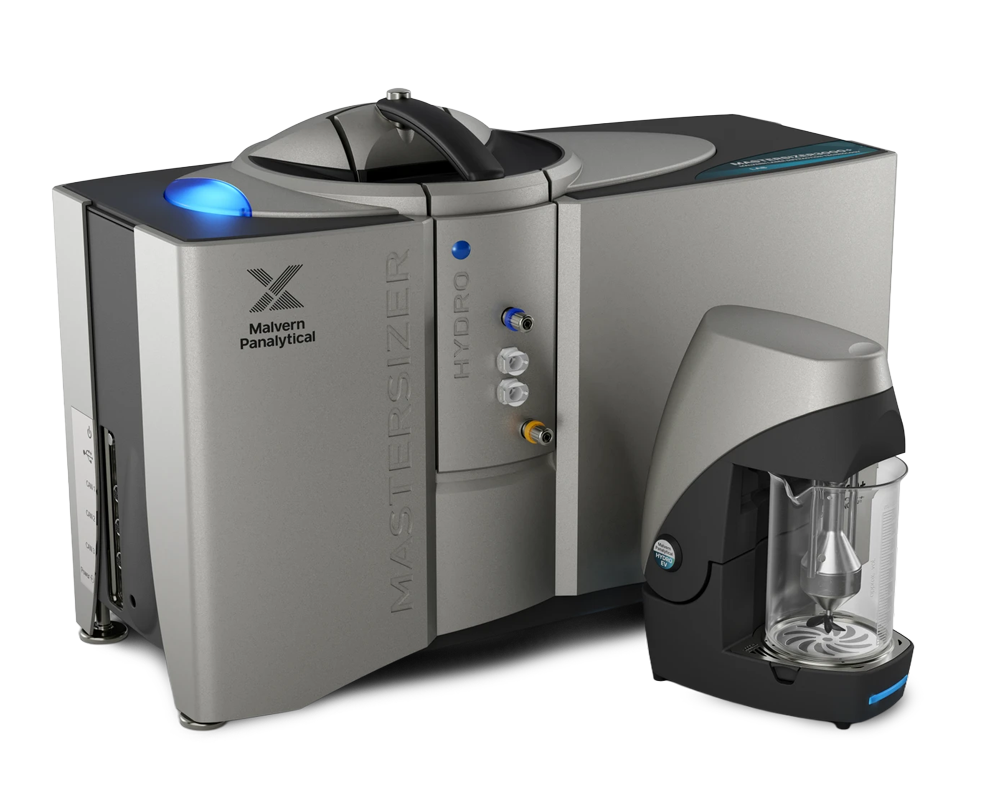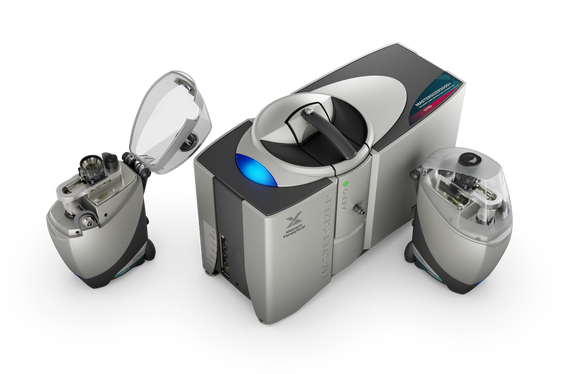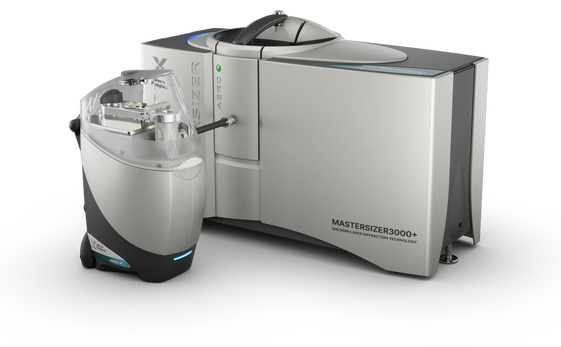
The Mastersizer 3000+ Lab is an entry level system for particle size analysis by laser diffraction. This system offers robust size measurements from 0.1 to 1000 microns and benefits from the core experience of the Mastersizer Xplorer software.
The Mastersizer 3000+ Lab provides a cost-effective, entry-level particle sizing experience which can be upgraded as required.
 Works with OmniTrust: Malvern Panalytical's compliance solution for the regulated environment
Works with OmniTrust: Malvern Panalytical's compliance solution for the regulated environment

The Mastersizer 3000+ Lab uses the technique of laser diffraction to measure the size of particles. It does this by measuring the intensity of light scattered as a laser beam passes through a dispersed particulate sample.
This data is then analysed to calculate the size of the particles that created the scattering pattern.

A typical system is made up of three main elements:

Powder flowability is important in maintaining manufacturing efficiency for many processes. Inconsistent powder flow can directly affect product quality variables such as the content uniformity of pharmaceutical dosage forms, or may lead to process variability as powder feed inconsistencies change the effectiveness of particle size reduction processes. Powder flow is a critical consideration in the manufacture of sintered products using additive manufacturing or 3D-printing techniques. Here, poor flow during powder bed deposition may lead to variations in powder bed density, resulting in defects that reduce the strength of the finished part.
Particle size and particle size distribution analysis are critical to understanding the flow properties of a powder, since these characteristics help predict how particles within the powder will pack and lock together. Powders that have a large particle size with a narrow size distribution tend to exhibit good flowability. Those with a small particle size, or a broad particle size distribution, tend towards poorer flowability because of the greater surface area of contact that exists between the particles and the ability of the fine particles present to fill the voids.
The packing density of particles influences the success of many processes, including mold-filling in ceramic and metal component production, powder coating, and the solids loading of suspensions. The way that particles pack together is a function of both their size and size distribution. Larger particles pack less efficiently than smaller ones, creating bigger voids. Broadening the particle size distribution improves packing efficiency by allowing smaller particles to pack the spaces between larger ones. Minimizing voidage is crucial to producing flaw-free sintered components. In powder coating, close packing enables efficient melting at lower temperatures, giving more time for cross-linking reactions between polymer particles for a better finish.
Particle packing also influences the rheology of suspensions, principally their viscosity. A mix of large and small particles has the least impact on the viscosity of the system because of their greater packing efficiency, a phenomenon that can be exploited to increase the solids loading of suspensions such as paints and ceramics.
The stability of suspensions and emulsions used and produced in industries such as pharmaceuticals and foods is important in ensuring product efficacy, acceptability, and success. Dispersion stability and gravitational separation are both key elements.
Dispersion stability: Achieving a stable dispersion requires control of the forces of adhesion and cohesion that exist between particles within a medium. These forces can lead to flocculation of emulsions or the creation of agglomerates within suspensions and powders. The risk of poor dispersion stability increases with decreasing particle size and can significantly impact processing. It may lead to powder conveyance issues within manufacturing processes, or problems with final product performance, such as the formation of agglomerates that give rise to imperfections in coatings and paints. Particle size and particle size distribution analysis is used in the management of dispersion stability risk and to identify the impact of stability problems on product performance and acceptance.
Gravitational separation: Improving the stability of a suspension or emulsion to gravitational separation relies on balancing the gravitational pull on the particles, a function of particle size and density, with the up-thrust of the suspending fluid, which depends on viscosity. In emulsions, particle size analysis is used to assess the likelihood of creaming, to which larger droplets are prone, and to monitor stability to flocculation and coalescence over time. Since droplet size and the degree of flocculation may also affect characteristics such as the mouthfeel of a food or the viscosity of a drink, particle size should be measured routinely when optimizing and manufacturing emulsion formulations.
The viscosity and flow of suspensions and slurries depend on different physical properties, including particle size and particle size distribution. If particle size decreases (for a constant volume fraction) and/or the size distribution increases, the sample viscosity will increase and the sample will flow less readily. Viscosity is important for many applications such as paints, cosmetics and battery manufacture. Take batteries, for example, where the battery electrodes are fabricated by applying a slurry of particles in suspension to metal foil. If the slurry is too viscous, this can lead to difficulties in the coating process.
Dissolution rates of materials are influenced by the specific surface area of the particulates. Increasing the specific surface area of particles by reducing their size accelerates the dissolution process. This correlation is especially important in pharmaceutical products, where dissolution directly impacts the bioavailability of a drug substance. Agrochemical and detergent manufacturers must also manage particle size to control the dissolution and release rates of active components within a formulation.
Ease of inhalation is an important criterion, both for preventing human inhalation of harmful particles and for optimizing drug deposition in the respiratory tract. For all orally inhaled and nasal drug products (OINDPs), particle size is a critical parameter, with clear size ranges specified for deposition and retention in the nasal cavity and for penetration to different areas of the lungs. In contrast, manufacturers of products such as cleaning materials and hairsprays must control fines to prevent inhalation, making particle size analysis essential to safety testing.
Reaction rates in solid systems are often a function of the specific surface area of the particles involved. The finer the particles, the larger their surface area to volume ratio, which promotes higher reaction rates. This is important in industries as diverse as cement, where particle size impacts the speed of hardening of cement products, and catalyst production, where particle size must be tailored to optimize reaction rates or ensure the effective scavenging of pollutants, and battery manufacture, where particle size must be controlled to balance between power density, charge times and battery durability.
Optical properties such as the light scattering ability of particles are exploited by paint, coatings and pigment manufacturers. The way a particle scatters light depends on its size, so manipulating the size of particles in a surface coating influences performance parameters such as hue and tint strength, product coverage and gloss.
Consumer perception of products such as foodstuffs is often influenced by particle size. For example, the particle size of coffee, and the extent to which it is ground, impact both the flavor released and the time required to brew. A fine particle size in chocolate gives a smooth mouthfeel, frequently perceived as superior to a grainy texture.
The curing properties of materials such as cement are affected by particle size. The curing qualities, and resultant compressive strength of cement, are increased as the particle size decreases due to the increase in surface area. Laser diffraction measures the particle size distribution, which is just as important as average size. If two cement samples have the same average size or surface area then the sample with the narrower size distribution will have a higher compressive strength.
Request a quote or talk to an expert for more information